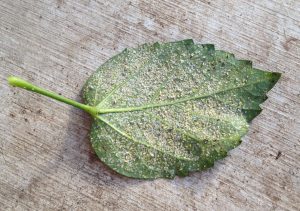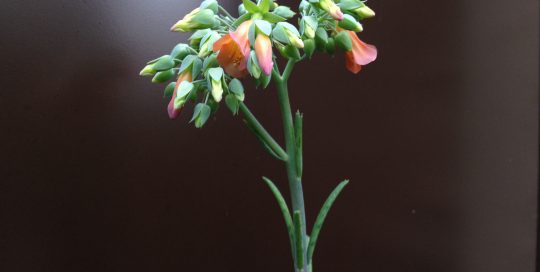Attack of the Whiteflies!
Views: 7856

I have a great opportunity to care for a small greenhouse this winter while the owners stay warm in sunny Florida. The greenhouse mostly houses ornamental plants, including several large cacti and jade plants that they’ve had for many, many years. No pressure, right? I just keep telling myself, don’t overwater, don’t overwater, DON’T OVERWATER! Turns out overwatering the succulents is the least of my concerns, because whiteflies are taking over the greenhouse!
I suspect a Hibiscus standard is the culprit responsible for introducing these little pests into the greenhouse. I noticed a few whiteflies before moving it into the greenhouse. To fix it, I sprayed with insecticidal soap, but I must have missed some. They are back with a vengeance and have spread to some of the other plants.
The Perpetrator
Whiteflies, as the name suggests, are small, winged, white, sap-sucking insects that are most apparent when a plant is moved and hordes of the adult bugs fly into the air. One of the reasons they are difficult to control is because of their short reproductive cycle. Whiteflies multiply rapidly and their generations overlap. Just when you think you’re getting ahead, the next generation appears. There are suddenly hundreds more flying around!
I tried insecticidal soap for the first couple of weeks. However, it’s hard to get thorough coverage on the underside of leaves. Of course this is where the eggs, nymphs, and adults hang out (see picture). Because of this, spraying was not very effective. Not only did spraying fail to control the whiteflies, but the residue started to build up on the leaves. This added to the sticky honeydew excreted from the whiteflies. I started to worry that the poor plant was going to suffocate. On a warm day, I drug it outside and hosed it off, vowing not to spray as much.
More Solutions
Next I installed a yellow light bulb after reading that whiteflies are attracted to them and would land and die on the hot bulb. True, but also not very effective. Then, I decided to try fly tape, those strips of super-sticky tape that come rolled up in a little canister and are available in four packs at any hardware store for a couple of dollars. Yellow sticky traps are what is actually recommended for whitefly control, but I never see them in stores, so I figured for a couple of bucks, no big loss if the fly tape doesn’t work. Lo and behold, they work!
Of course, fly tape looks terrible hanging everywhere covered in dead bugs, but at least I can see that it’s working. The odd thing is that whiteflies aren’t actually flies, but are related to aphids, mealybugs and scale, so I’m not quite sure why they are attracted to the tape. Maybe it’s the yellowish color, which whiteflies find irrestible. If you can’t find sticky traps and don’t want to mess with fly tape, traps can be made at home by painting a piece of cardboard yellow and covering it in a sticky material like Tanglefoot or petroleum jelly.
Last Resort
If the fly tape fails to control the whitefly population, my next step is to drag my vacuum cleaner into the greenhouse, suck up all the adult bugs I can, and dispose of them in the garbage outside of the greenhouse. Next, if that fails, I am going to remove the fly tape and release parasitic wasps or ladybugs in the greenhouse. If it all fails, then I will give up, chuck that Hibiscus into the compost pile, and buy them a new one in the spring. Wish me luck!
Meet Abbi Hayes
Abbi's Recent Posts

Kalanchoe delagoensis: Mother of Millions







